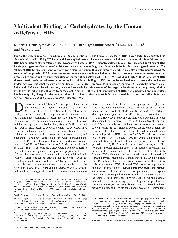摘要
Four of the six human alpha-defensins (human neutrophil peptides 1-3 and human a-defensin 5; HD5) have a lectin-like ability to bind glycosylated proteins. Using HD5 as a model, we applied surface plasmon resonance techniques to gain insights into this property. HD5 bound natural glycoproteins > neoglycoproteins based on BSA > nonglycosylated BSA >> free sugars. The affinity of HD5 for simple sugars covalently bound to BSA was orders of magnitude greater than its affinity for the same sugars in solution. The affinity of HD5 for protein-bound carbohydrates resulted from multivalent interactions which may also involve noncarbohydrate residues of the proteins. HD5 showed concentration-dependent self-association that began at submicromolar concentrations and proceeded to dimer and tetramer formation at concentrations below 5 mu M. The (R9A, R28A) and (RDA, R32A) analogs of HD5 showed greatly reduced self-association as well as minimal binding to BSA and to BSA-affixed sugars. From this and other evidence, we conclude that the extensive binding of HD5 to (neo)glycoproteins results from multivalent nonspecific interactions of individual HD5 molecules with carbohydrate and noncarbohydrate moieties of the target molecule and that the primary binding events are magnified and enhanced by subsequent in situ assembly and oligomerization of HD5. Self-association and multivalent binding may play integral roles in the ability of HD5 to protect against infections caused by viruses and other infectious agents. The Journal of Immunology, 2009, 183: 480-490.
- 出版日期2009-7-1
